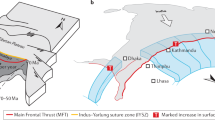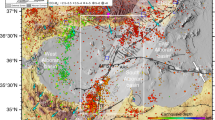Abstract
The great Assam earthquake of 12 June 1897 reduced to rubble all masonry buildings within a region of northeastern India roughly the size of England, and was felt over an area exceeding that of the great 1755 Lisbon earthquake1. Hitherto it was believed that rupture occurred on a north-dipping Himalayan thrust fault propagating south of Bhutan2,3,4,5. But here we show that the northern edge of the Shillong plateau rose violently by at least 11 m during the Assam earthquake, and that this was due to the rupture of a buried reverse fault approximately 110 km in length and dipping steeply away from the Himalaya. The stress drop implied by the rupture geometry and the prodigious fault slip of 18 ± 7 m explains epicentral accelerations observed to exceed 1g vertically and surface velocities exceeding 3 m s-1 (ref. 1). This quantitative observation of active deformation of a ‘pop-up’ structure confirms that faults bounding such structures can penetrate the whole crust. Plateau uplift in the past 2–5 million years has caused the Indian plate to contract locally by 4 ± 2 mm yr-1, reducing seismic risk in Bhutan but increasing the risk in northern Bangladesh.
This is a preview of subscription content, access via your institution
Access options
Subscribe to this journal
Receive 51 print issues and online access
$199.00 per year
only $3.90 per issue
Buy this article
- Purchase on Springer Link
- Instant access to full article PDF
Prices may be subject to local taxes which are calculated during checkout



Similar content being viewed by others
References
Oldham, R. D. Report on the Great Earthquake of 12 June 1897. Mem. Geol. Soc. India 29, 1–379 (1899).
Seeber, L. & Armbruster, J. in Earthquake Prediction: An International Review (eds Simpson, D. W. & Richards, P. G. 259–277 (Maurice Ewing Series, Vol. 4, American Geophysical Union, Washington DC, 1981).
Molnar, P. & Pandey, M. R. Rupture zones of great earthquakes in the Himalayan Region. Proc. Indian Acad. Sci. (Earth Planet. Sci.) 98, 61–70 (1989).
Molnar, P. The distribution of intensity associated with the great 1897 Assam earthquake and bounds on the extent of the rupture zone. J. Geol. Soc. India 30, 13–27 (1987).
Gahalaut, V. K. & Chander, R. A rupture model for the great earthquake of 1897, northeast India. Tectonophysics 204, 163–174 (1992).
Bond, J. in Annual Report of Triangulation 1897–1898 (ed. Strahan, C.) Part II, xii–xiii (Survey of India Department, Calcutta, 1899).
Burrard, S. G. Great Trigonometrical Survey of India, North East Longitudinal Series, Synoptical Volume 35 (Survey of India, Dehra Dun, 1909).
Wilson, C. A. K. Triangulation of the Assam Valley Series, Geodetic Report 1938, 10–22 (Survey of India, Dehra Dun, 1939).
Strahan, G. Great Trigonometrical Survey of India, Assam Valley Triangulation, Synoptical Volume 32 (Survey of India, Calcutta, 1891).
Nagar, V. K., Singh, A. N. & Prakesh, A. Strain pattern in N. E. India inferred from geodetic triangulation data. Mem. Geol. Soc. India 23, 265–273 (1992).
Frank, F. C. Deduction of earth strains from survey data. Bull. Seismol. Soc. Am. 56, 35–42 (1966).
Okada, Y. Surface deformation due to shear and tensile faults in a half-space. Bull. Seismol. Soc. Am. 75, 1135–1154 (1985).
Das, J. D., Saraf, A. K. & Jain, A. K. Fault tectonics of the Shillong Plateau and adjoining regions, northeast India, using remote sensing. Int. J. Remote Sensing 16, 1633–1646 (1995).
Gomberg, J. & Ellis, M. Topography and tectonics of the central New Madrid seismic zone: results of numerical experiments using a three-dimensional boundary element program. J. Geophys. Res. 99, 20299–20310 (1994).
Chen, W.-P. & Molnar, P. Source parameters of earthquakes and intraplate deformation beneath the Shillong Plateau and the northern Indoburman ranges. J. Geophys. Res. 95, 12527–12552 (1990).
Le Dain, A. Y., Tapponier, P. & Molnar, P. Active faulting and tectonics of Burma and surrounding regions. J. Geophys. Res. 89, 453–472 (1984).
Khattri, K. N. Seismological investigations in north eastern region of India. Mem. Geol. Surv. India 23, 275–302 (1992).
Verma, R. K. & Mukhopadhay, M. An analysis of the gravity field in northeastern India. Tectonophysics 42, 283–317 (1977).
Ambraseys, N. Reappraisal of North Indian earthquakes at the turn of the 20th century. Current Sci. 79, 1237–1250 (2000).
Murthy, M. V. N., Talukdar, S. C., Bhattacharya, A. C. & Chakrabarti, C. The Dauki Fault of Assam. Bull. Oil Natural Gas Commission 6, 57–64 (1969).
Johnson, S. J. & Alam, A. M. N. Sedimentation and tectonics of the Sylhet trough, Bangladesh. Geol. Soc. Am. Bull. 103, 1513–1527 (1991).
Evans, P. The tectonic framework of Assam. J. Geol. Soc. India 5, 80–96 (1964).
Paul, J. et al. Active deformation across India. Geophys. Res. Lett. 28, 647–651 (2001).
Sukhija, B. S. et al. Timing and return of major paleoseismic events in the Shillong Plateau, India. Tectonophysics 308, 53–65 (1999).
Rogers, J. Chains of basement uplifts within cratons marginal to orgenic belts. Am. J. Sci. 287, 661–692 (1987).
Lyon-Caen, H. & Molnar, P. Gravity anomalies, flexure of the Indian Plate, and the structure, support and evolution of the Himalaya and Ganga basin. Tectonics 4, 513–538 (1985).
Lipman, P. W., Protska, H. J. & Christiansen, R. L. Evolving subduction zones in the western United States, as interpreted from igneous rocks. Science 174, 821–825 (1971).
Dickinson, W. R. & Snyder, W. S. Plate tectonics of the Laramide orogeny. Geol. Soc. Am. Mem. 151, 355–366 (1978).
Jordan, T. E. et al. Andean tectonics related to the geometry of the subducted Nazca plate. Geol. Soc. Am. Bull. 94, 341–361 (1983).
Bilham, R. & Gaur, V. K. The geodetic contribution to Indian seismotectonics. Current Sci. 79, 1259–1269 (2000).
Bilham, R., Larson, K., Freymueller, J., & Project Idylhim members. GPS measurements of present-day convergence across the Nepal Himalaya. Nature 386, 61–64 (1997).
Sibson, R. H. & Xie, G. Dip range for intracontinental reverse fault ruptures: the truth not stranger than friction. Bull. Seismol. Soc. Am. 88, 1014–1022 (1998).
Acknowledgements
This work was funded by the National Science Foundation and the Natural Environment Research Council. R.B. received a John Simon Guggenheim Memorial Foundation fellowship while at Oxford University.
Author information
Authors and Affiliations
Corresponding author
Rights and permissions
About this article
Cite this article
Bilham, R., England, P. Plateau ‘pop-up’ in the great 1897 Assam earthquake. Nature 410, 806–809 (2001). https://doi.org/10.1038/35071057
Received:
Accepted:
Issue Date:
DOI: https://doi.org/10.1038/35071057
This article is cited by
-
Seismic Hazard Assessment and Source Zone Delineation in Northeast India: A Case Study of the Kopili Fault Region and Its Vicinity
Indian Geotechnical Journal (2024)
-
Upper mantle deformation beneath the northeastern part of Indian plate from shear-wave splitting analysis
Geo-Marine Letters (2024)
-
Flash flood potential risk zonation mapping using GIS-based spatial multi-index model: a case study of Sunamganj District, Bangladesh
Arabian Journal of Geosciences (2024)
-
Evidence of Surface Rupture from the 1897 Chedrang Valley Earthquake (Mw ~ 8.1) on the Shillong Plateau: Insights from MASW, Resistivity Sounding, and Fluvial Geomorphology
Pure and Applied Geophysics (2024)
-
Petrogenesis of the Borjuri diorite pluton in the Mikir Massif of Northeast India: implications for post-collisional intermediate magmatism during the Pan-African orogeny
Acta Geochimica (2023)
Comments
By submitting a comment you agree to abide by our Terms and Community Guidelines. If you find something abusive or that does not comply with our terms or guidelines please flag it as inappropriate.



